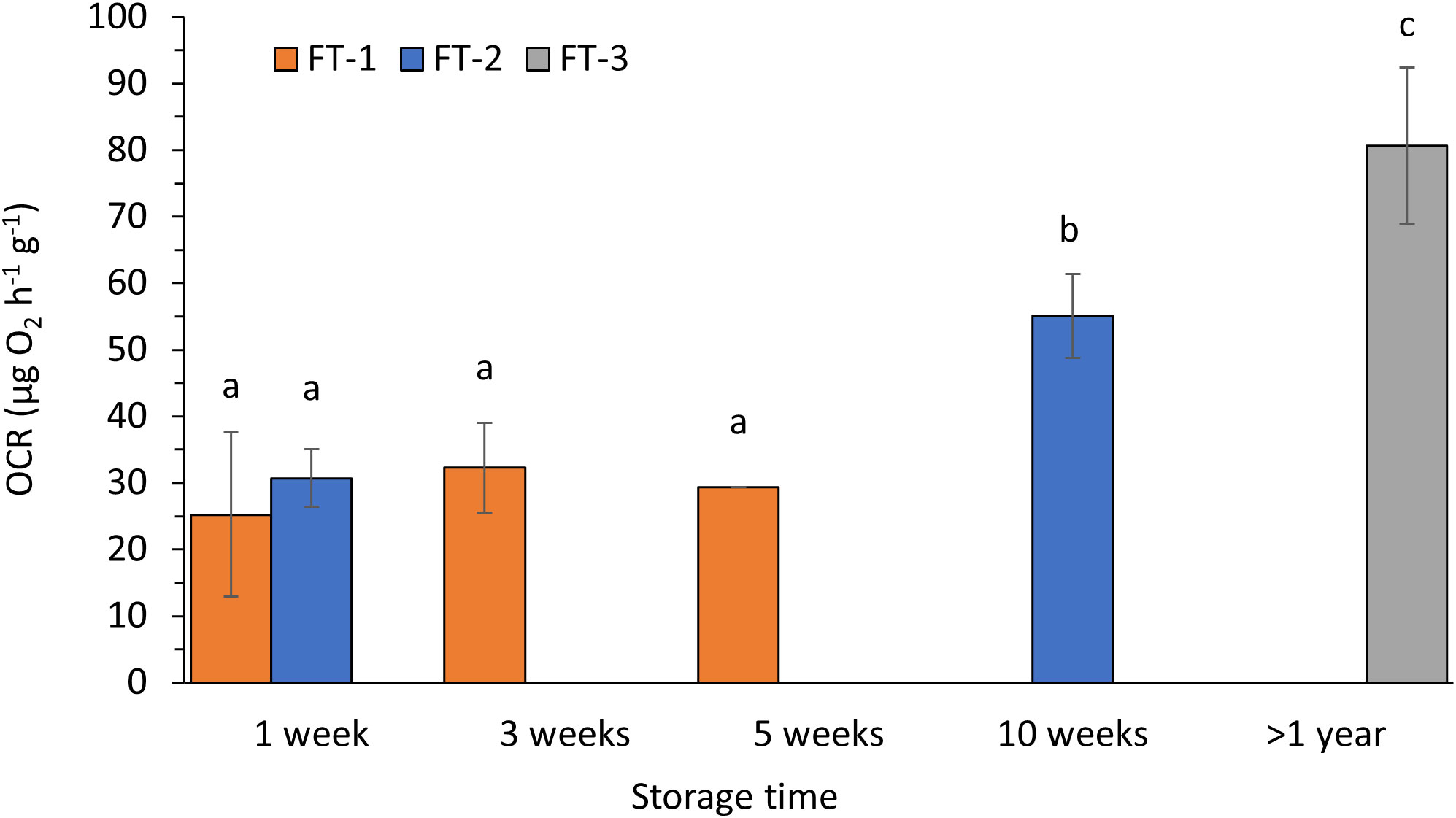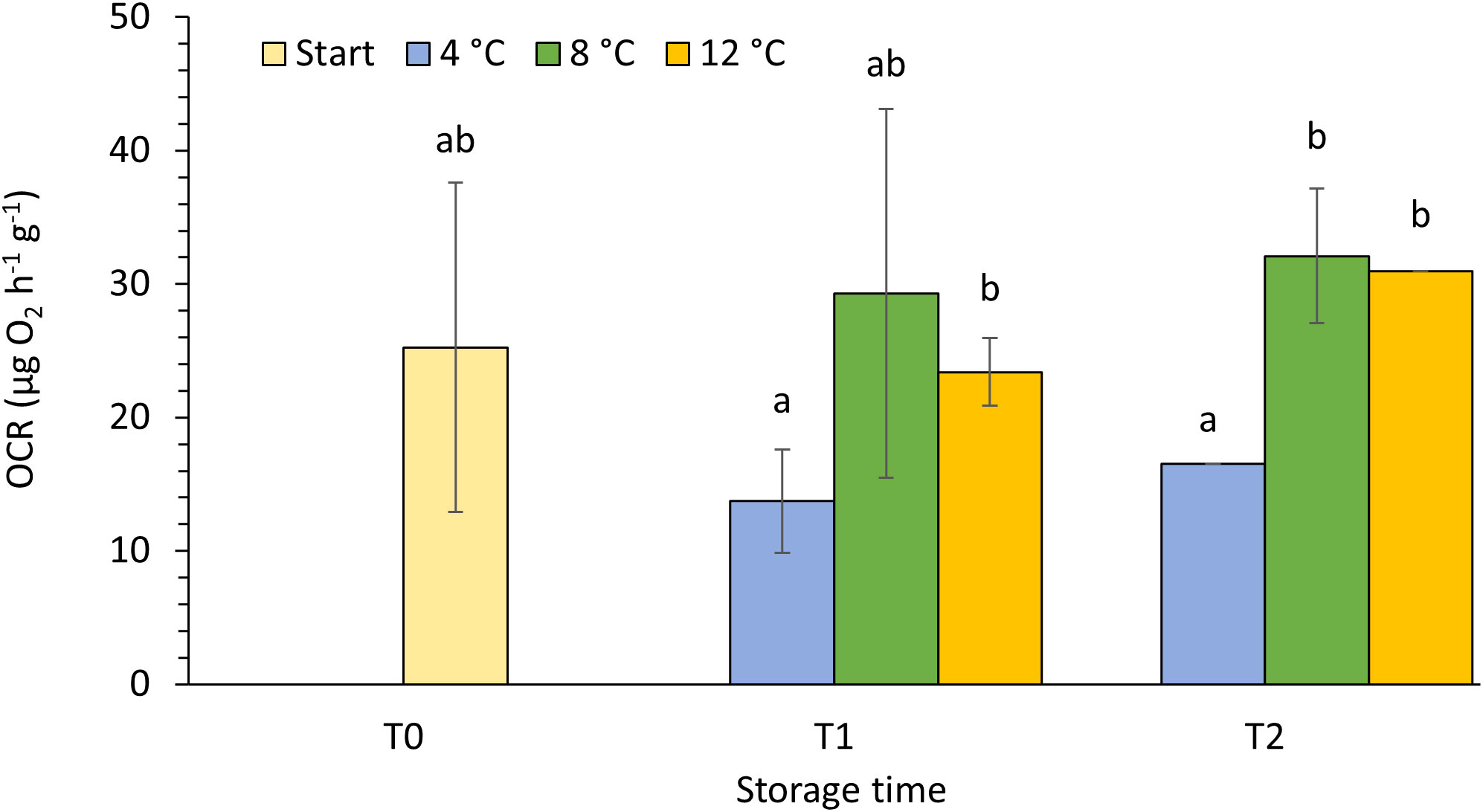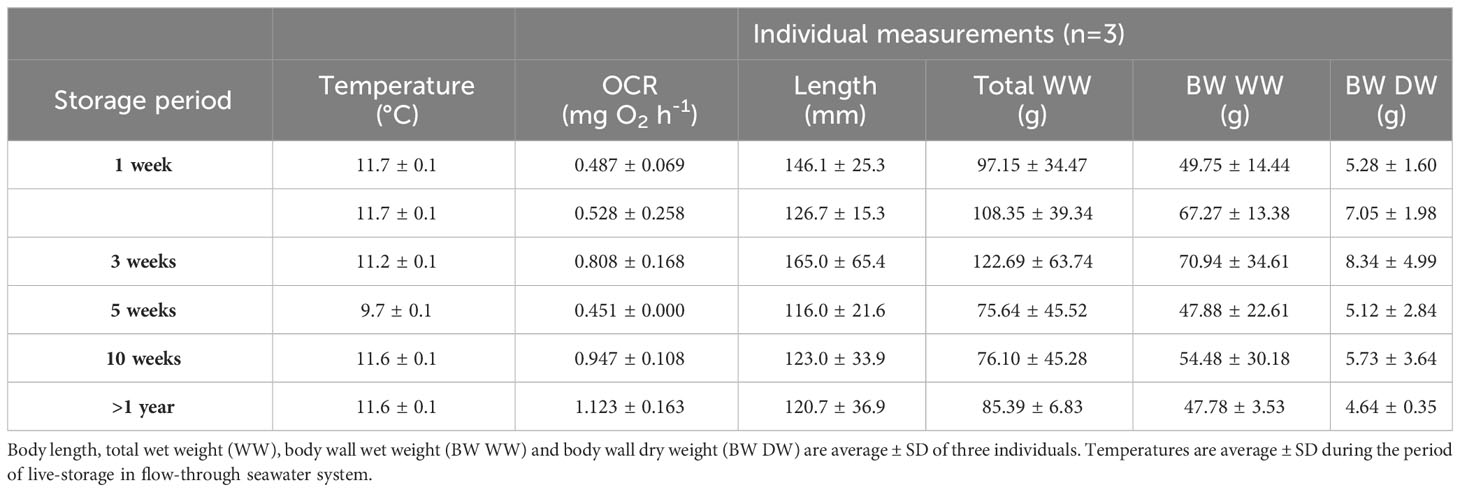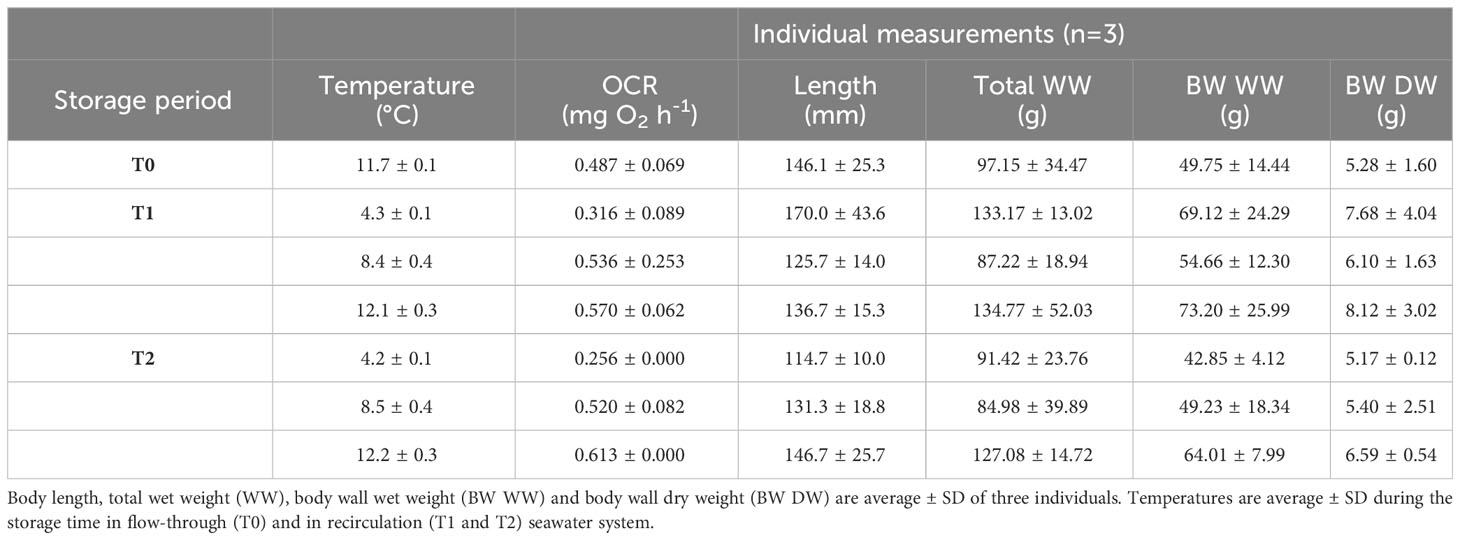
94% of researchers rate our articles as excellent or good
Learn more about the work of our research integrity team to safeguard the quality of each article we publish.
Find out more
CORRECTION article
Front. Mar. Sci., 08 December 2023
Sec. Marine Fisheries, Aquaculture and Living Resources
Volume 10 - 2023 | https://doi.org/10.3389/fmars.2023.1327753
This article is part of the Research TopicSea Cucumbers: The Sustainability of Emergent and Historical ResourcesView all 12 articles
This article is a correction to:
Effect of live-storage period and temperature on oxygen consumption rate in the cold-water sea cucumber Parastichopus tremulus
A Corrigendum on
Effect of live-storage period and temperature on oxygen consumption rate in the cold-water sea cucumber Parastichopus tremulus
by Landes AM, Sunde J and Christophersen G (2023) Front. Mar. Sci. 10:1248840. doi: 10.3389/fmars.2023.1248840
In the published article, there was an error in Figure 1 and Figure 3 as well as in Table 1 and Table 2 as published. The authors discovered a continuous error throughout all calculations used to determine oxygen consumption rate (OCR) in Parastichopus tremulus. Instead of using oxygen partial pressure (as required), air pressure was erroneously used. Since air temperature was stable throughout the experiments, oxygen density in air followed the atmospheric pressure and the proportion remained the same throughout all measurements. Therefore, the overall relation between the OCR measured at different times and in different treatments remained the same, the statistical results still applied, and all general findings remained correct. In effect, only the scale (y-axis) had to be corrected in Figures 1 and 3. The corrected Figure 1 and Figure 3 and their captions appear below. In Tables 1 and 2, numerical values given for OCR had to be updated. The corrected Table 1 and Table 2 and their captions appear below.

Figure 1 Oxygen consumption rates (OCR) per hour and gram body wall dry weight in P. tremulus from three sampling groups (1-3) at different live-storage time in a flow-through seawater system (FT). Data are average ± SD of three consecutive measurements per sampling point. Different letters denote significant different values.

Figure 3 Oxygen consumption rates (OCR) per gram body wall dry weight and hour in P. tremulus at experimental start (T0), after 2 (T1) and 4 (T2) weeks live-storage at three different temperatures (4, 8 and 12°C). Data are average ± SD of three consecutive measurements per sampling point. Different letters denote significant different values.

Table 1 Oxygen consumption rates (OCR) per group of three individuals are average ± SD of three consecutive measurements.

Table 2 Oxygen consumption rate (OCR) per group of three individuals are average ± SD of three consecutive measurements.
The authors apologize for this error and state that this does not change the scientific conclusions of the article in any way. The original article has been updated.
In the published article, there was an error. Due to the continuous calculation error mentioned above, the numerical values of oxygen consumption rates mentioned in the text were incorrect. The text itself remained unchanged.
A correction has been made to Results, 3.1 Effect of live-storage period, Paragraph 1. These two consecutive sentences previously stated:
“Weight specific OCR in animals kept for up to 5 weeks remained at similar levels (Figure 1, FT-1, one-way ANOVA, p=0.593), while OCR measurements after 10 weeks of live-storage showed a significant increase from initially ~150 µg O2 h-1g-1 body wall dry weight (BW DW) to ~270 µg O2 (Figure 1, FT-2, unequal variances t-test, p=0.005). Sea cucumbers, kept in the flow-through seawater system >1 year, displayed even higher OCR of ~390 µg O2 h-1g-1 BW DW (Figure 1, FT-3, unequal variances t-test, p=0.045).”
The two corrected consecutive sentences appear below:
“Weight specific OCR in animals kept for up to 5 weeks remained at similar levels (Figure 1, FT-1, one-way ANOVA, p=0.593), while OCR measurements after 10 weeks of live-storage showed a significant increase from initially ~31 µg O2 h-1g-1 body wall dry weight (BW DW) to ~55 µg O2 (Figure 1, FT-2, unequal variances t-test, p=0.005). Sea cucumbers, kept in the flow-through seawater system >1 year, displayed even higher OCR of ~81 µg O2 h-1g-1 BW DW (Figure 1, FT-3, unequal variances t-test, p=0.045).”
Another correction has been made to Results, 3.2 Effect of temperature during short-term live-storage, Paragraph 1. The original sentences previously stated:
“While oxygen demand at 4°C had almost halved compared to initial measurements at T0, consumption at 8 and 12°C remained unchanged at about 150 µg O2 h-1g-1 dry weight throughout the four-week period.”
The corrected sentence appears below:
“While oxygen demand at 4°C had almost halved compared to initial measurements at T0, consumption at 8 and 12°C remained unchanged at about 31 µg O2 h-1g-1 dry weight throughout the four-week period.”
A correction has been made to Discussion, Paragraph 1.
The sentence previously stated:
“The highest OCR values measured in this study (~390 µg O2 g-1h-1) were associated with animals that had been fed regularly and stored for more than a year, but also animals kept without supplementary feed had a significantly higher oxygen demand (~270 µg O2 g-1h-1 vs. ~150 µg O2 g-1h-1) after 10 weeks of storage when compared with animals just brought in to the lab.”
The corrected sentence appears below:
“The highest OCR values measured in this study (~81 µg O2 h-1g-1) were associated with animals that had been fed regularly and stored for more than a year, but also animals kept without supplementary feed had a significantly higher oxygen demand (~55 µg O2 h-1 g-1 vs. ~31 µg O2 h-1g-1) after 10 weeks of storage when compared with animals just brought in to the lab.”
A correction has been made to Discussion, Paragraph 5.
The sentence previously stated:
“Measurements conducted at 4°C after two weeks (T1) of acclimation in the lab revealed a mean consumption of 1.54 mg O2 per group of three individuals per hour (mean 133 g wet weight per individual).”
The corrected sentence appears below:
“Measurements conducted at 4°C after two weeks (T1) of acclimation in the lab revealed a mean consumption of 0.32 mg O2 per group of three individuals per hour (mean 133 g wet weight per individual).”
A correction has been made to Discussion, Paragraph 6.
These two consecutive sentences previously stated:
“He conducted measurements at 6°C and measured individual rates that ranged from 130 up to 427 µg O2 h-1g WW-1. The mean OCR of the one individual (130 g wet weight) measured by Fox (1936) was 334 µg O2 h-1g WW-1. Using total wet weight as reference, our converted values translate to average 790 µg O2 h-1g WW-1 for individuals kept at 12°C and average 513 µg O2 h-1g WW-1 for individuals kept at 4°C.”
The two corrected consecutive sentences appear below:
“He conducted measurements at 6°C and measured individual rates that ranged from 0.7 up to 2.3 µg O2 h-1g WW-1. The mean OCR of the one individual (130 g wet weight) measured by Fox (1936) was 1.8 µg O2 h-1g WW-1. Using total wet weight as reference, our converted values translate to average 1.65 µg O2 h-1g WW-1 for individuals kept at 12°C and average 0.86 µg O2 h-1g WW-1 for individuals kept at 4°C.”
The sentence previously stated:
“Newell and Courtney (1965) measured consumption rates of 23.14 to 66.43 µg O2 h-1g DW-1 in adult Holothuria forskali at 17°C, compared to our measurements of 67 µg O2 h-1g DW-1 in adult P. tremulus at 4°C and 156 µg O2 h-1g DW-1at 12°C.”
The corrected sentence appears below:
“Newell and Courtney (1965) measured consumption rates of 23.14 to 66.43 µg O2 h-1g DW-1 in adult Holothuria forskali at 17°C, compared to our measurements of 15 µg O2 h-1g DW-1 in adult P. tremulus at 4°C and 27 µg O2 h-1g DW-1 at 12°C.”
The authors apologize for this error and state that this does not change the scientific conclusions of the article in any way. The original article has been updated.
All claims expressed in this article are solely those of the authors and do not necessarily represent those of their affiliated organizations, or those of the publisher, the editors and the reviewers. Any product that may be evaluated in this article, or claim that may be made by its manufacturer, is not guaranteed or endorsed by the publisher.
Keywords: sea cucumber, Holothuroidea, Parastichopus tremulus, oxygen consumption, live-storage, temperature, condition index
Citation: Landes AM, Sunde J and Christophersen G (2023) Corrigendum: Effect of live-storage period and temperature on oxygen consumption rate in the cold-water sea cucumber Parastichopus tremulus. Front. Mar. Sci. 10:1327753. doi: 10.3389/fmars.2023.1327753
Received: 25 October 2023; Accepted: 28 November 2023;
Published: 08 December 2023.
Edited and Reviewed by:
Pedro M. Félix, Center for Marine and Environmental Sciences (MARE), PortugalCopyright © 2023 Landes, Sunde and Christophersen. This is an open-access article distributed under the terms of the Creative Commons Attribution License (CC BY). The use, distribution or reproduction in other forums is permitted, provided the original author(s) and the copyright owner(s) are credited and that the original publication in this journal is cited, in accordance with accepted academic practice. No use, distribution or reproduction is permitted which does not comply with these terms.
*Correspondence: Gyda Christophersen, Z3lkYS5jaHJpc3RvcGhlcnNlbkBtb3JlZm9yc2tpbmcubm8=
Disclaimer: All claims expressed in this article are solely those of the authors and do not necessarily represent those of their affiliated organizations, or those of the publisher, the editors and the reviewers. Any product that may be evaluated in this article or claim that may be made by its manufacturer is not guaranteed or endorsed by the publisher.
Research integrity at Frontiers

Learn more about the work of our research integrity team to safeguard the quality of each article we publish.